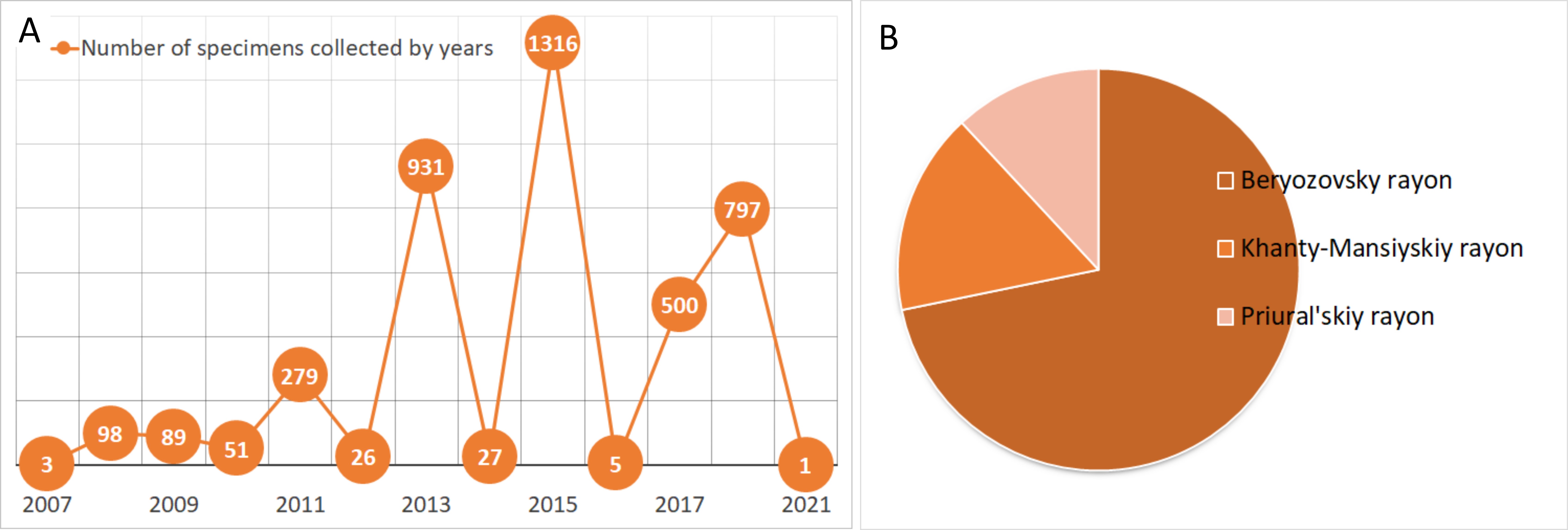Bryological collection of YSU
The purpose of the Bryological collection of YSU was to made a collection of mosses and liverworts, representing various biogeographical areas and the species diversity of the Khanty-Mansi Autonomous Okrug, which would be accessible by bryologists worldwide. The study of the Khanty-Mansi Autonomous Okrug in terms of bryology is still insufficient. The regional checklist of species is quite complete, but frequency data is scarce (including rare and endangered species) due to the small number of surveyed areas.
The growth of Bryological collection began when Elena D. Lapshina started working in the Khanty-Mansi Autonomous Okrug — Yugra. The first specimens were collected in 2003-2004 in the vicinity of the Khanty-Mansiysk town. In 2009, the Mukhrino Field Station of Yugra State University was established on the left bank of the Irtysh River, 25 southwest of Khanty-Mansiysk. As a part of the inventory program of this station, about 600 samples of mosses and liverworts were collected, representing a typical bryoflora of the middle taiga of Western Siberia (Lapshina and Pisarenko 2013).
A significant part of the collection of bryophytes (2141 samples) was made during a series of expeditions organized by the Museum of Nature and Man (Khanty-Mansiysk) at the eastern slope of the Subpolar Urals. In 2013 the region of Neroyka mountain – one of the highest peaks of the Ural Mountains, was inventoried (Konstantinova and Lapshina 2014, Lapshina et al. 2015, Lapshina et al. 2016). The upper reaches of the Puyva river were visited in the field season of 2015 (Konstantinova and Lapshina 2017, Skuchas and Lapshina 2018). In 2019, the large collection of bryophytes (683 specimens) was made in upper and middle reaches of the Khulga River (Lapshina et al. 2020). These collections from Khanty-Mansi region were supplemented in 2017 by about 500 specimens of mosses and liverworts from the eastern slope of the Polar Urals in Yamalo-Nenets Autonomous Okrug, Yanganape carbonate mountain range.
A small collection (168 specimens) was made in 2017 in a unique mire system on the territory of «Vogulka» protected area. Other well-sampled areas include nature parks «Kondinskie Ozera» and «Numto». To date, specimens from about 20 key areas have been accessed in the collection.
The collection is located in the main campus of Yugra State University in Khanty-Mansiysk (Chekhova str., 16, 2nd building, 2nd floor, 203 room).

Herbarium, vascular plants collection of YSU
The Herbarium of Yugra State University originated from the geobotanical surveys made in the Northern West Siberia. Although initially it was not intended as a systematic collection of plants of that region, the accumulated specimens have made a separate subdivition of the Biological Collection of YSU. The herbarium represent collections made mainly by Elena D. Lapshina, Ilya V. Filippov during the field work in Khanty-Mansi and Yamal-Nenets regions since the beginning of the XXI century.
The collection was not managed and was stored in the «collected in the field» state till recently. Last year we started revision, preparation and digitization of this collection. From totally about 1.5K specimens.
The collection is located in the main campus of Yugra State University in Khanty-Mansiysk (Chekhova, 16, 2nd building, 2nd floor, 203 room).
Last update: 16.02.2024
